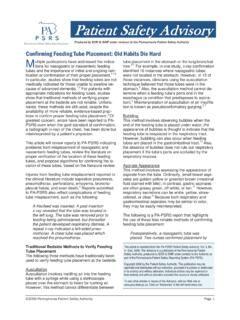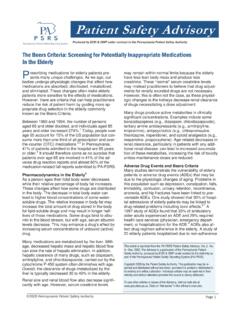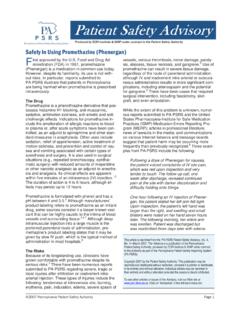Transcription of PATIENT SAFETY: COLOR BANDING Standardization and ...
1 PATIENT SAFETY: COLOR BANDING Standardization and Implementation Manual THE COLOR OF SAFETY Administrative Guide Pennsylvania Hospitals BANDING Together for PATIENT SafetyWayneHoly SpiritTylerPocono GeneralASRHMid-ValleyMoses TaylorPA DOHM arian CommunityCMCM ercyPatient Safety i Table of ContentsChapter 1 Safety First/Overview ..2 Chapter 2 Hospital Specific documentation Policy Adoption ..3-5 Implementation Action Consent for Refusal (sample)..7 Photo ID documentation (sample)..8 Chapter 3 Staff Education Chapter 4 PATIENT Education Content.
2 10 Room 11 Chapter 5 Community Education .. 12 Community Charity sample letter ..13 Community Caregiver sample letter ..14 Rainbow Poster ..15 Chapter 6 Equipment Selection Band Procurement ..16 Kardex Core Committee Membership .. 18 2 Chapter 1 Safety First The first PATIENT Safety Authority, issued Dec 14,,2005 alerted Pennsylvania hospitals to the risks associated with COLOR coded PATIENT wrist 3 Chapter 2 Policy 1. Purpose A clearly defined and consistently implemented practice for identifying and communicating PATIENT risk factors or special needs by standardizing the use of COLOR -coded bands to support optimal safe care, based upon the PATIENT s assessed needs and wishes.
3 2. Risk Reduction Strategies for COLOR -Coded Bands To reduce the risk of potential for confusion associated with the use of COLOR -coded wristbands that communicate PATIENT safety risks, the Hospital has joined a consortium of local and regional hospitals who have agreed to standardize the meanings of specific colors of bands. The hospitals have also adopted the following strategies for COLOR -band alerts: The spectrum of COLOR -coded wrist bands has been limited. To reduce misinterpretation of secondary colors, a preprinted embossed descriptive text is used on the bands clarifying the intent.
4 Except in emergent situations, no handwriting is used on the band. Colored wrist bands may only be applied or removed by a nurse. If labels or stickers ( stickers ) are used in the medical record to communicate risk factors or band application, the stickers will have a corresponding COLOR and text to the colored band. Non-hospital ( community ) bands are prohibited to be worn in the hospital setting and are removed or covered by the nurse on admission to avert confusion with the colored-hospital band. Community bands include charity and fashion bands. PATIENT and family education is conducted on risks associated with community bands and in the meanings of the hospital wrist bands that have been applied.
5 3. Definitions The following chart presents the meaning of each COLOR -coded band: Band COLOR Communicates Red Allergy Yellow Fall Risk GGGrrreeeeeennn Latex Allergy Purple DNR Pink Restricted
6 Extremity 4 4. Admission ID Bands and Pre-Registration ER Bands The colorless, or clear admission ID band, and the pre-registration emergency room yellow ID band, are applied in accordance with procedures outlined in organizational policy on PATIENT ID and registration. Colorless admission ID bands and temporary yellow pre-registration bands may be applied by non-clinical staff in accordance with organizational policy. 5. Community Bands Following admission ID, the admitting nurse examines the PATIENT for community (charity or fashion) bands.
7 If community bands are present, the nurse will explain the risks associated with the bands during hospitalization, and the PATIENT will be asked to remove the band(s). If the PATIENT agrees, the nurse removes the band. If the PATIENT refuses, the nurse will cover the band with medical tape, and request the PATIENT sign a refusal form acknowledging the risks associated with the community band. 6. COLOR -Coded Hospital Bands During the initial assessments, data is collected to evaluate the needs of the PATIENT and analyzed to develop a plan of care unique to the individual. Reassessment is ongoing and may be triggered by key decision points, or at intervals specified by the disciplines directly involved in providing PATIENT treatment and/or care.
8 It is during the initial and reassessment procedures that risk factors associated with falls, allergies, DNR status or restricted extremity are identified or modified. Because this is an interdisciplinary process , it is important to identify who has responsibility for applying and removing COLOR -coded bands, how this information is documented and how it is communicated. The following procedures have been established to remove uncertainty in these processes: Except in circumstances involving a restricted extremity, any PATIENT demonstrating risk factors on initial assessment will have a colored-band placed on the same extremity as the admission ID band by the nurse.
9 The application of the band is documented in the chart by the nurse, per hospital policy. If stickers are used to document in the record, the stickers must correspond to band COLOR and text. Upon application of the colored band, the nurse will instruct each PATIENT that the band is not to be removed. In the event that any colored band or bands have to be removed for the treatment of the PATIENT , the nurse will remove the bands, new bands will be made, risks reconfirmed, and the bands placed on another extremity immediately by the nurse. 5 7. PATIENT Refusal or Incapable If the PATIENT is capable and refuses to wear the COLOR -coded band, an explanation of the risks will be provided to the PATIENT / family.
10 The nurse will reinforce that it is their opportunity to participate in efforts to prevent errors, and it is their responsibility as part of the team. The nurse will document in the medical record PATIENT refusals, and the explanation provided. The PATIENT will be requested to sign an acknowledgement of refusal by the completion of a release. If the PATIENT is incapable, combative, or refuses to wear a colored band, a photo ID will be taken and the colored alert bands or matching alert stickers will be affixed to the photo ID form to communicate the band message to staff. This form may be copied and attached to the PATIENT s transfer records to support hand-off communication.

















